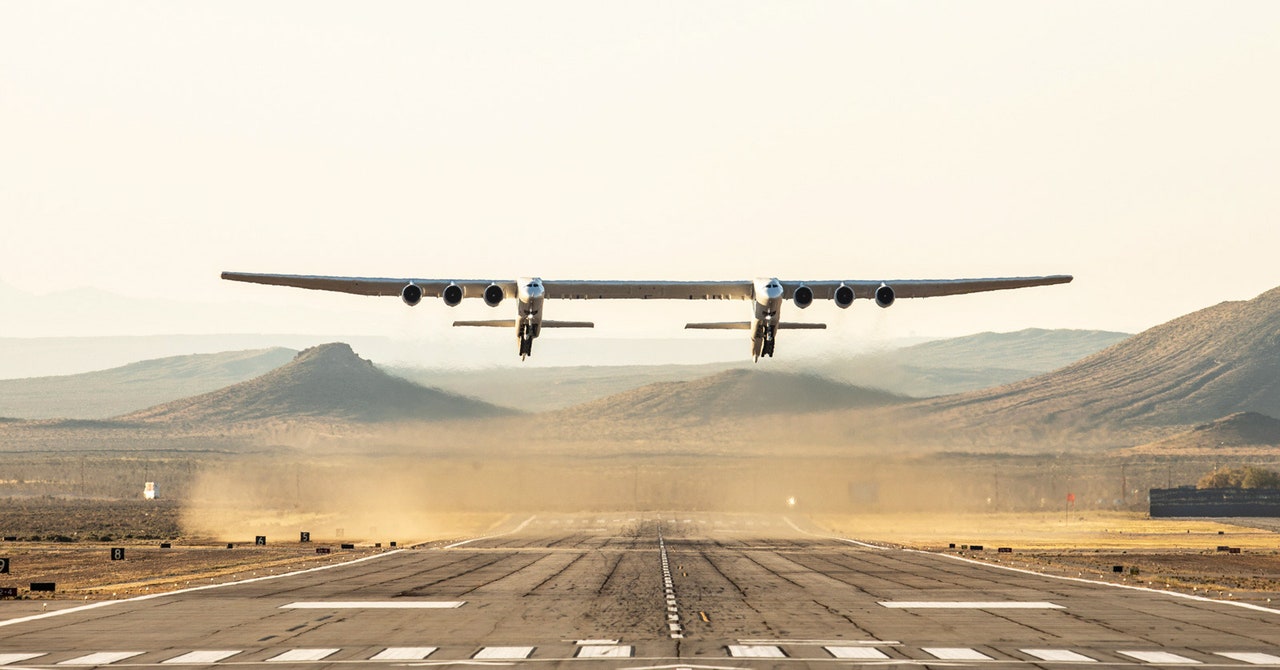Hey, everyone. Elon now doesn’t want to buy Twitter because it can’t count its bots. You’d think an AI guy like him would let the robots speak.
The Plain View
Stratolaunch was based on a dream. Paul Allen, the unspeakably wealthy cofounder of Microsoft, had grown up in the thrall of space exploration, devouring books like the visionary rocketry tomes of science writer Willy Ley. In the early 2000’s, Allen funded a project known as Spaceship One, which snared the X-Prize as the first private venture to send a human into space. He later licensed the technology to Virgin Galactic, which built its own carrier vehicle to send Richard Branson into sub-orbital ecstasy. Meanwhile, Allen, frustrated with what he considered NASA’s timidity, decided to get back into the space business. He retained the legendary aircraft engineer Burt Rutan to design a giant carrier that could launch satellites and other spacecraft beyond the skies. With its twin fuselages and 385-foot wingspan, the Stratolaunch plane, later dubbed Roc, was a breathtaking spectacle in itself, doubly so because of its mission to lift its cargo to the heavens. In 2018, I trekked to the Mojave desert to see the world’s biggest airplane for myself.
But when Allen died in November 2018, after a third bout of the lymphoma that had dogged him for decades, his space dream died as well. While Stratolaunch still lives, it has no designs on crossing the Karman line. It is now an unabashed defense contractor, specializing in what the UN Office for Disarmament Affairs called “a new and destabilizing strategic weapon”: hypersonic technology that propels programmed airborne craft at speeds of Mach 5 and above.
Here’s how that happened. Upon his death, Allen’s holding company Vulcan, which included Stratolaunch, as well as sports teams and an AI think tank, fell to his sister Jodie. Apparently she had no wish to retain a space venture, offering Stratolaunch to buyers for $400 million, far less than her brother’s investment. It was unclear whether there would be any takers for the world’s biggest plane. Richard Branson, who chronically underplays Allen’s contribution to his own space venture, jokingly offered a dollar.
But one mysterious buyer emerged: Cerberus, a private equity firm named after the mythical three-headed dog who guards the gates of hell. When Vulcan made the sale in October 2019, Stratolaunch not only withheld the purchase sum, but also who bought it; reporters discovered the identity through SEC reports some months later. Maybe that was because Cerberus, run by cofounder Stephen Feinberg, has some baggage. It once tried to create a personal weapons juggernaut called Freedom Group by scooping up arms makers like Remington and Bushmaster. In 2012, Cerberus tried to divest itself of the group after a mass murderer used a Bushmaster to slaughter 20 schoolchildren and six teachers at Sandy Hook; ultimately it shifted the assets to its Remington company, which declared bankruptcy in 2018. On top of all that, Feinberg once reportedly joked that if any of his employees had their picture in the paper, “We will do more than fire that person, we will kill him.”
After buying Stratolaunch in late 2019, the private equity firm bulked up the workforce from 13 employees to more than 250 and refocused the company’s mission specifically on hypersonic vehicles. These had been considered as potential payloads during the Allen era, but they were secondary to satellite-launching and a possible manned vehicle called Black Ice. Using a carrier vehicle for hypersonic craft has its advantages; Roc can launch its rocket-propelled cargo over the ocean, where the ear-crushing sonic boom wouldn’t be so disruptive. Feinberg himself is knowledgeable about the defense establishment and served under Donald Trump as the head of the President’s Intelligence Advisory board. In December 2021, Stratolaunch won a contract from the Missile Defense Agency for a feasibility study on how the US might take countermeasures against hypersonic attacks. Stratolaunch is building its own hypersonic missiles, codenamed Talon. The first is intended for a single launch—after the test it will drop into the ocean. The second is a reusable hypersonic vehicle that will retain the key data after tests. For now, the intent is defensive, to mimic the behavior of potential attack missiles. But Stratolaunch doesn’t rule out a future role in creating offensive hypersonic weapons.


































